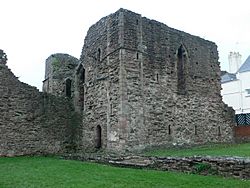Battle of Monmouth (1233) facts for kids
Quick facts for kids Battle of Monmouth |
|||||||
|---|---|---|---|---|---|---|---|
| Part of the rebellion of Richard Marshal against Henry III | |||||||
 The ruined Great Tower of Monmouth Castle |
|||||||
|
|||||||
| Belligerents | |||||||
| Commanders and leaders | |||||||
| Baldwin III | Richard Marshal | ||||||
| Strength | |||||||
| ? | ? | ||||||
| Casualties and losses | |||||||
| Heavy | |||||||
The Battle of Monmouth was an important fight in 1233. It happened on November 25, near the town of Monmouth in Wales. This battle was part of a bigger conflict in England.
The main people involved were King Henry III of England and Richard Marshal. Richard Marshal was a powerful English noble. He had joined forces with Welsh Prince Llywelyn ap Iorwerth.
Contents
Why Did the Battle of Monmouth Happen?
A King and a Rebellious Noble
Richard Marshal was a strong leader among the English nobles. He did not agree with King Henry III. Marshal felt the King was giving too much power to his foreign friends. These friends were from a place called Poitou.
In August 1233, King Henry asked Marshal to come to his court. Marshal refused to go. Because of this, King Henry declared Marshal a traitor. This meant the King saw him as an enemy.
Marshal's Fight for Power
After being called a traitor, Richard Marshal went to his castle at Chepstow. King Henry and his army moved towards Abergavenny. Marshal then teamed up with Owain ap Gruffydd, a Welsh leader.
Together, they attacked and took over several castles. These included Cardiff and Newport. They also attacked Abergavenny and Grosmont. King Henry's army then had to retreat.
What Happened During the Battle?
Scouting the Town
Richard Marshal and his knights arrived at Monmouth. They wanted to check out the town before attacking it. They were seen near the walls of Monmouth Castle.
A nobleman named Baldwin III, Count of Guînes saw them. Baldwin was from Flanders. King Henry had put him in charge of defending Monmouth. Baldwin had soldiers from Flanders and Poitou.
A Clever Trap
Baldwin thought Marshal had only a few followers with him. He decided to ride out with his soldiers to chase Marshal. But Baldwin was wrong.
Marshal had planned a trap. He quickly turned his forces around. This caught Baldwin and his soldiers by surprise. A fierce fight began. Marshal's forces won a big victory.
What Happened After the Battle?
Marshal's Next Steps
Baldwin survived the battle. After the fight, the local lord, John of Monmouth, returned. He took control of the town again.
Richard Marshal then traveled to Ireland. He wanted to gather more supporters there. He made a truce, or peace agreement, with King Henry in early 1234.
Marshal's Final Days
Sadly, Richard Marshal died soon after the truce. He passed away from injuries he got in another battle. This battle was called the Battle of the Curragh.
Where Was the Battle Fought?
Historians believe the battle took place at a spot called Castle Field. This area is west of the River Monnow. Today, it is known as Vauxhall Fields.
Some sources also suggest that the Monnow Bridge was important in the fighting. This bridge is near the Church of St Thomas the Martyr. It may have been partly destroyed during the battle.
Images for kids


